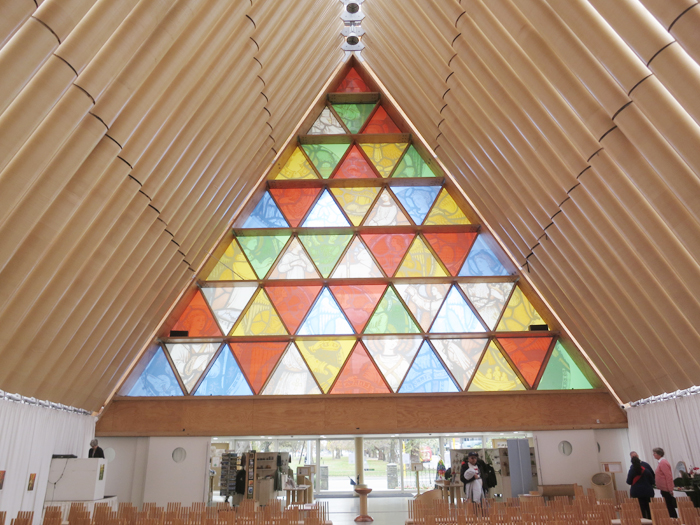Recovery from disastrous events like floods and earthquakes involves vision and imagination as well as hard yakka.

Christchurch’s new “Cardboard Cathedral”
Hobart and Christchurch have a lot in common. They’re around the same latitude and each is the main centre on a southern island. They also tell us quite a bit about natural disasters.
Natural disasters are by definition beyond human control, but people can and do influence them. What we do after the event can make a huge difference to the ultimate outcome, but we can also play a part in causing or preventing them.
The failure to extinguish fires burning ahead of Hobart’s biggest natural disaster, the 1967 bushfires, increased the likelihood of a conflagration, though maybe not by much. But the fingerprints of human excess are all over the flash floods of 11 days ago. I’ll come back to that.
Christchurch’s biggest disaster was definitely natural. Situated close to the boundary between two major tectonic plates, it was free of major quakes for nearly a century until getting a painful reminder of its vulnerability over four years of tormenting tremors that started in 2010.
More than 14,000 tremors, including some big ones in which 186 people died, made recovery for business and residents difficult or impossible and rendered some suburbs uninhabitable by turning the ground to a black liquid. I can’t imagine a more crippling or dispiriting experience.
Many left and did not return, but those who stayed, helped by a national Natural Disaster Fund, are steadily bringing the city back from the brink.
The tremors ended nearly four years ago. While on a family visit to New Zealand this month, I was struck by the buzz of construction activity around the city centre and a general air of people up and about. Christchurch is well and truly on the move.
A disaster like this, in which most major buildings were damaged and many destroyed, is a rare opportunity for visionary thinking. It offers a strong incentive for authorities and citizens to think big, about innovations they’d like to see, what should be kept and what scrapped.
The great stone cathedral that once dominated the city’s heart now lies in ruins, encircled by weeds and a high fence. A couple of blocks away, a temporary structure designed by Japanese architect Shigeru Ban offers a vision of a new cathedral, and the contrast with the old couldn’t be more stark.
The “Cardboard Cathedral” features a translucent polycarbonate roof supported by large cardboard tubes, a feature wall of coloured glass, neatly-integrated shipping containers for offices, and comfortable seating for 700. The interior is bright, cheerful and informal.
With much of its built heritage reduced to rubble, the city is choosing a different persona. The new Christchurch aims to be the world’s most people-friendly city, and has employed Jan Gehl, the same Danish urban designer who advised Hobart City a few years ago, to help it get there.
Bicycle paths are everywhere, cars are being restricted in the city centre, pedestrian-only precincts are opening up and the public transit system is one that any city would be proud to own. The city aims to be among the world’s most resilient, climate-friendly cities.
Hobart, too, has such aspirations, and its administration has rightly earned accolades for innovations in transport, waste management and energy use. Which makes last month’s deluge seem like a kick in the guts.
The fact is, had the world acted decisively on scientific advice 20 years ago to make deep cuts to the use of fossil fuels, events like this would tend to be less damaging today. But faced with denial and prevarication among political leaders, that turned out to be beyond us.
In those 20 years we’ve learned a lot about how global warming affects rainfall. A warm atmosphere lifts the rate of evaporation from land and sea while being able to hold more moisture. The 1C of man-made warming to date has increased moisture in the atmosphere by about 7 per cent.
That doesn’t mean fewer droughts – many parts of Australia are likely to get more of those – but it does increase the prospect of rain falling in large dollops. A 2017 US-Swiss study found that in most places rainfall will become as much as 15 per cent more intense for every degree of warming.
Recent observations tend to support this broad, global study. In Australia, extreme rain events are increasing in both frequency and intensity. The CSIRO and the Bureau of Meteorology estimate that this century will see a steady rise in the number of such events for most of Australia.
The US has seen a strong upward trend in extreme rain events. The US Global Change Research Program calculated in 2014 that one-in-five-year precipitation events, measured over two days, have quadrupled since the 1960s.
The impact of these events on cities’ stormwater and sewage infrastructure is huge. Such public facilities are generally designed around averages, but extreme rain events, like earthquakes, are as sporadic and unpredictable as they are devastating.
We can’t stop either of these from happening, but we can mitigate the impact of extreme weather by cutting global carbon emissions everywhere, starting now. As it happens, that fits neatly with making cities more liveable.
